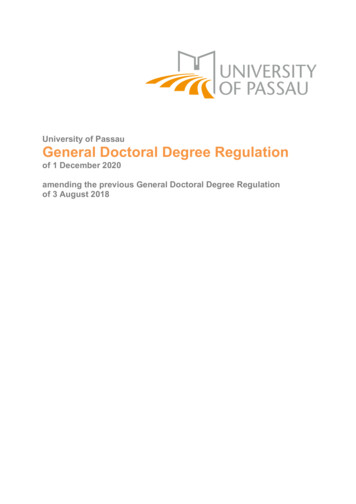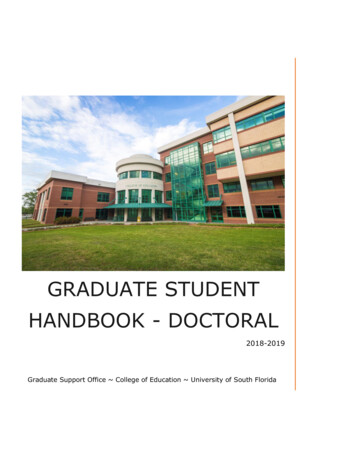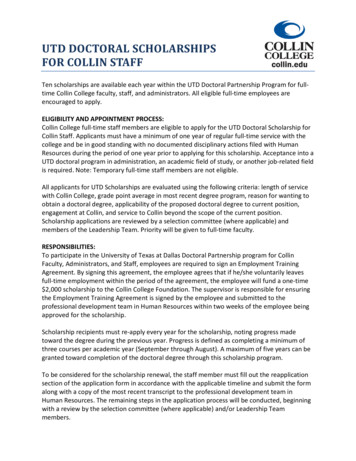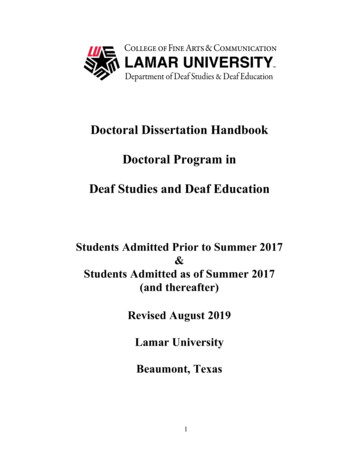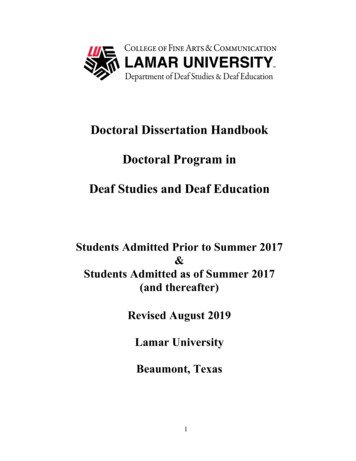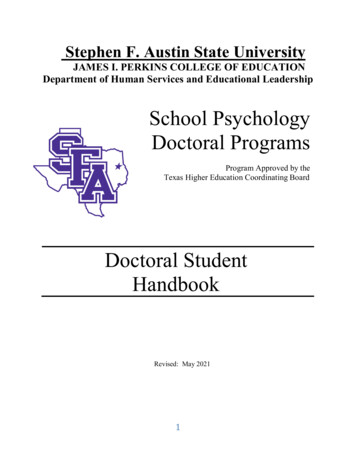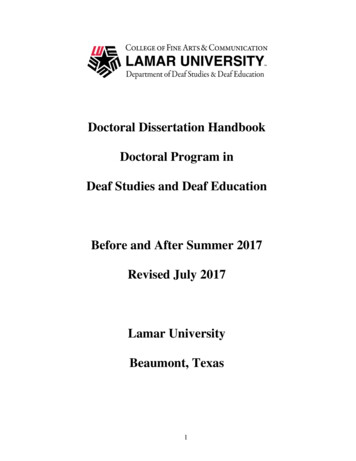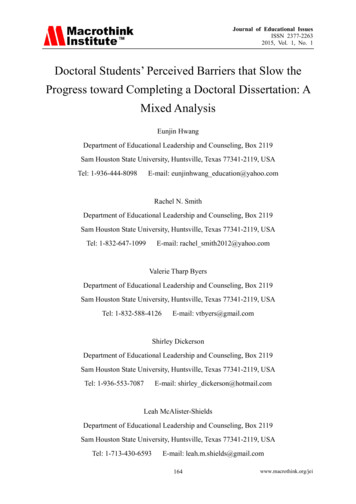
Transcription
Emerging Directions in Doctoral EducationDifferentiation and Integration: Managing the Paradox in Doctoral EducationJon F. Wergin Laurien AlexandreArticle information:Downloaded by Doctor Jon Wergin At 12:24 04 April 2016 (PT)To cite this document: Jon F. Wergin Laurien Alexandre . "Differentiation andIntegration: Managing the Paradox in Doctoral Education" In Emerging Directions inDoctoral Education. Published online: 31 Mar 2016; 225-242.Permanent link to this 000006019Downloaded on: 04 April 2016, At: 12:24 (PT)References: this document contains references to 0 other documents.To copy this document: permissions@emeraldinsight.comAccess to this document was granted through an Emerald subscription provided 386E8194FBD:For AuthorsIf you would like to write for this, or any other Emerald publication, then pleaseuse our Emerald for Authors service information about how to choose whichpublication to write for and submission guidelines are available for all. Please visitwww.emeraldinsight.com/authors for more information.About Emerald www.emeraldinsight.comEmerald is a global publisher linking research and practice to the benefit of society.The company manages a portfolio of more than 290 journals and over 2,350 booksand book series volumes, as well as providing an extensive range of online productsand additional customer resources and services.Emerald is both COUNTER 4 and TRANSFER compliant. The organization is a partnerof the Committee on Publication Ethics (COPE) and also works with Portico and theLOCKSS initiative for digital archive preservation.*Related content and download information correct at time of download.
Downloaded by Doctor Jon Wergin At 12:24 04 April 2016 (PT)DIFFERENTIATION ANDINTEGRATION: MANAGING THEPARADOX IN DOCTORALEDUCATIONJon F. Wergin and Laurien AlexandreABSTRACTWe review the two dominant models of doctoral education, and arguethat both of them are limited in their effectiveness by excessive differentiation. The traditional doctoral model is characterized by highly specialized faculty training new academics; the new wave of professionaldoctorates is characterized by disaggregated faculty roles, standardizedcurricula, and a managerial culture. Both models overemphasize differentiation, albeit for different reasons, with negative impacts on studentcompletion, faculty engagement, and needs of the larger society.Differentiation is an antagonistic force to effective integration, and inthis chapter we describe how one program, Antioch University’s PhD inLeadership & Change, intentionally holds this essential tension by: (1)optimizing faculty’s professional expertise while nurturing collectiveresponsibility; (2) ensuring both individual and organizational efficacy;and (3) nurturing a culture of critical reflection. By intentionallyEmerging Directions in Doctoral EducationInnovations in Higher Education Teaching and Learning, Volume 6, 225 242Copyright r 2016 by Emerald Group Publishing LimitedAll rights of reproduction in any form reservedISSN: 2055-3641/doi:10.1108/S2055-364120160000006019225
226JON F. WERGIN AND LAURIEN ALEXANDRErestoring equilibrium through effective integrating devices, doctoral programs can mediate the excesses of extreme differentiation in ways thatbenefit individual and organizational health, student learning, and ultimately society as a whole.Downloaded by Doctor Jon Wergin At 12:24 04 April 2016 (PT)INTRODUCTIONOne of the many challenges doctoral education struggles with today is inproviding learning environments where learners thrive, completion ratesare high, and faculty are valued, productive, and engaged. We have beenstruck by an apparent disequilibrium: Leaning too heavily on faculty expertise and scholarly productivity, as traditional doctoral education is proneto do, can lead to academic cultures in which student learning comes in second and completion rates suffer; on the other hand, too much emphasis onnarrowly defined learning at the expense of engaged and expert faculty, assome newer models promote, can diminish the quality of the curriculum.The problem with both the traditional and the newer online models is oneof excessive differentiation. In this chapter, we argue that doctoral programs of quality require an equal attention to integration.Doctoral programs offered by traditional research universities have beenthe object of significant criticism over the past several decades: They areoften considered overly specialized, oblivious to societal needs, and inattentive to employment demands within and beyond the academic marketplace.Furthermore, rigid on-site residency requirements exclude many talented“new majority” students whose professional and personal circumstancesmake them unable to devote four or more years to fulltime, on-campusstudy. All of this results in high attrition, low completion rates, and dismaljob prospects for many of those who do graduate (Berliner, 2006; Golde,2006; Walker, Golde, Jones, Bueschel, & Hutchings, 2009; Wulff & Austin,2004).A recent wave of professional and online doctorates has addressedthese problems, at least in part, by serving those excluded from traditionaldoctoral programsnamely, practicing professionals and other “nontraditional” students who seek a doctoral degree for career advancementand need to do so on their own time and in their own place. For-profitinstitutions offering doctoral education have tapped into a huge market forthese students, promising degrees that require little if any travel, flexibilityin residency requirements, and curricular attention to marketplace demands
Downloaded by Doctor Jon Wergin At 12:24 04 April 2016 (PT)Differentiation and Integration227(Ghezzi, 2007). In a market seemingly focused more on job competenciesthan human capabilities, these new entries have gained a strong foothold, although recent enrollment declines suggest that the bloom may befading (Hodgman, 2014; Korn, 2012; Lamar, 2013; Rubin, 2012; Stynes,2015).Even though the traditional site-based research university doctorate andthe new wave of professional doctorates serve different students and havedifferent purposes, they face similar limitations, due to excessive differentiation. Traditional doctoral programs are differentiated by design: They arecharacterized by highly specialized scholarly expertise as the path to facultyproductivity, and a culture that expects students to become “stewards of adiscipline” by becoming as equally specialized as their mentors. This is onlyreinforced when the route to promotion and tenure lies primarily in differentiating oneself from others through specialized scholarly work. Given theprimacy of this focus, inattention to student learning is a chronic problem.The newer models are differentiated in an entirely different way: Everypart of the curriculumplanning, delivery, assessment, advisingis segmented, disaggregated, and often farmed out to individuals performingdifferent roles the designer, the instructor, the evaluator, the advisor, andso forth. One type of differentiation has been replaced by another. A disaggregated faculty workforce is matched with a narrowly defined, careerspecialized curriculum designed to train students as “stewards of a specificprofession.” Integration of student learning is assumed to occur through theaccumulation of course credits, which paradoxically is exactly what highereducation reformers have been arguing against for decades (Guskin, 1994).In this chapter, we argue that designing doctoral programs to educatestudents to be stewards of a traditional discipline serves only a small sliverof those interested in doctoral education. Likewise, designing programswith the primary purpose of educating students to be stewards of a specificprofession by demonstrating sets of skills does not fully serve their interests, either. Excessive differentiation in both models leads to a less-effectiveteaching/learning culture (Singleton & Session, 2011). Instead, we want toencourage a model of doctoral education that focuses on preparing students as scholar-practitioners to be “stewards of society,” and with this asits focus, departmental structures need to incorporate faculty expertise andproductivity in ways that are more collaborative, cross-professional, andintegrative. This is differentiation with integration for the benefit of students, faculty, and the larger society. Later in this chapter we describe whatsuch a model in practice looks like; but first we describe the organizationallens we use.
228JON F. WERGIN AND LAURIEN ALEXANDREDownloaded by Doctor Jon Wergin At 12:24 04 April 2016 (PT)DIFFERENTIATION WITH INTEGRATION: AN EARLYBUT USEFUL THEORETICAL PERSPECTIVEA half-century ago, Paul Lawrence and Jay Lorsch published a seminalarticle in Administrative Science Quarterly titled, “Differentiation andIntegration in Complex Organizations” (1967). Their work has been widelycited ever since in numerous business and industry contexts (Andriopoulos &Lewis, 2009; Smith & Tushman, 2005; Tushman & O’Reilly, 1996). Theauthors defined organization as a “system of interrelated behaviors of peopleperforming a task that has been differentiated into distinct subsystems, eachperforming a portion of the task, and the efforts of each being integratedto achieve effective performance of the system” (1967, p. 3). The authorsargued that effective performance depends on the organization’s abilityto interact with, and adapt to, a changing environment. They proceeded todefine differentiation as a “state of segmentation of the organizational systeminto subsystems, each of which tends to develop particular attributes inrelation to the requirements posed by its relevant external environment”(pp. 3 4), and integration as “the process of achieving unity of effortamong the various subsystems in the accomplishment of the organization’stask” (p. 4).Lawrence and Lorsch studied six companies in the chemical industry,created composite scores on both differentiation and integration, and thencompared these with scores of overall organizational performance. What isremarkable and most relevant for this chapter is that the low-performingorganizations were high on one or the other scale, but not both, whereasthe two high-performing companies were both highly differentiated andwell integrated.Since the high-performing companies were able to optimize two seemingly antagonistic pulls, differentiation and integration, Lawrence andLorsch investigated how they were able to do this, and found that thehigh-performing companies used “integrative devices” in the form of crossfunctional teams and task forces. The effectiveness of these integrativedevices depended on six “determinants”:1. An intentional balancing of interests: between short-term and long-termproblems, and an “intermediate structure” that allowed for an “interpersonal orientation”;2. A focus on professional expertise rather than blind adherence to hierarchical authority;
Differentiation and Integration229Downloaded by Doctor Jon Wergin At 12:24 04 April 2016 (PT)3. A concern with organizational performance rather than just individualachievement;4. Perceived “high influence” throughout the organization rather than aconcentration of power at the top;5. Influence and decision-making centered at the “requisite level”; and6. Modes of conflict resolution that focus primarily on problem-solvingand a relative absence of conflict avoidance. Effective integrators recognize that conflict among differentiated units is normal, even critical fororganizational health and growth.Most recently, attending to both differentiation and integration has beencited as a way to manage the “strategic paradoxes” leaders face (Smith,2014). Paradoxes are an essential part of an organization’s strategicdecision-makingthey represent neither problems to solve nor dilemmasto resolve. Instead, paradoxes must be managed and held in an appropriatetension. After looking at how six top management teams managed oneof these paradoxesintroducing innovation versus finding efficiencies inproducing existing products Smith concluded that balancing differentiation with integration was central to sustaining commitments to the healthytension this and other paradoxes pose.APPLICATIONS TO HIGHER EDUCATIONThis organizational lens has promise, especially given that doctoral programs are characterized by high degrees of differentiation and specialization. Scholars of academic organizations will immediately recognizethe similarity of the six determining factors to what is known about effective leadership practice in colleges and universities. For example, one of us(Wergin, 2003) has written extensively about the academic departmentand has found that effective departments share a set of qualities that, inretrospect, bear a striking resemblance to Lawrence and Lorsch’s integrative devices: a balance in focus on students, community, institution, anddiscipline (Determinant 1); a high value on professional autonomy(Determinant 2); cultures of collective responsibility, where all stakeholdersfeel accountable for the success of the department as a whole, ratherthan just their own individual work and career trajectory (Determinant 3);group commitment to the welfare of the institution and the community(Determinant 4); support for innovation, entrepreneurialism, and reasonable risk (Determinant 5); and a setting conducive to constructive discourse
Downloaded by Doctor Jon Wergin At 12:24 04 April 2016 (PT)230JON F. WERGIN AND LAURIEN ALEXANDRE(Determinant 6). In other words, effective academic departments have strongintegrating devices. Furthermore, Lawrence and Lorsch’s work presagedmuch of the current thinking on topics such as relational leadership(Cunliffe & Eriksen, 2011), and complexity leadership (Uhl-Bien, Marion, &McKelvey, 2007), both of which have been extensively applied to academicorganizations of all types (Kezar, Carducci, & Contreras-McGavin, 2006).Oddly however, despite the pervasive influence of the Lawrence and Lorschresearch, the overarching theme of balancing differentiation and integrationhas only rarely been applied to higher education contexts.Nevertheless, we find differentiation with integration to be a particularlyuseful explanatory concept when applied to doctoral education. As we havenoted, extreme differentiation has been a consistent theme in both traditional and more recent professional and online doctoral programs; and inour view, the lack of attention to the need for corresponding integrationhas stifled faculty engagement and collective creativity, negatively impactedstudent learning, and diminished stewardship of society’s complex challenges by foregoing reflective practice and concentrating instead on whatSchon (1983) called “technical rationality.”At the same time, directly applying Lawrence and Lorsch’s six factors toacademic organizations, as is, does not take into account the distinctivequalities of academic culture in general, and doctoral programs in particular. Further, the authors themselves suggested that these “integrativedevices” are likely not independent determinants but highly interrelatedthat is, the presence or absence of one likely enhances or diminishesanother.Evidence available to us suggests that this is certainly true in academicorganizations. We have reconceptualized the six factors in the followingway. First, what the authors described as “intentional balancing of interests” (Determinant 1) we choose to call holding essential tensionsthatsuccessful integration depends on an academic program’s ability to holdcertain paradoxes in a healthy equilibrium. We see the next two pairs of“integrative devices” as two of the essential tensions. The first pair is optimizing faculty’s professional expertise (Determinant 2), while also nurturinga culture of collective responsibility (Determinant 3). The second pair isensuring that faculty, despite their specializations, have influence both intheir individual professional practices, or individual efficacy (Determinant4), and on the program as a whole, or organizational efficacy (Determinant5). Finally, we see the sixth factor, an “emphasis on problem-solving,” asnecessary for the tensions to be held in appropriate balance. We call thislast factor a culture of critical reflection (Determinant 6). We elaborate on
Differentiation and Integration231the renamed factors below, and then demonstrate how they work in onedoctoral program, Antioch University’s PhD in Leadership & Change.Downloaded by Doctor Jon Wergin At 12:24 04 April 2016 (PT)Holding Essential TensionsDoctoral education programs must acknowledge and deal with “strategicparadoxes” (Smith, 2014). Paradoxes are different from “dilemmas”: one isnot making a difficult choice between competing values, but rather figuringout how to accomplish conflicting purposes, without choosing amongthem. In highly differentiated organizations like universities, the naturaltendency is for each sector to maximize its own productivity: Offices ofadmissions and recruitment want to maximize enrollment, while academicadvisors want fewer students with academic challenges; those in financewant to see increased revenue, often from gifts and contracts, while students want faculty attention focused on their studies and not on cultivatingdonors and writing grants; assessment offices want evidence of value-addedstudent learning, while faculty want to have smaller classes and teach whatthey want, not what they “have” to. In some ways, these interests overlap;in some waysmaybe mostthey do not. The conflicting interests areevident. To adapt Lawrence and Lorsch’s terms, short-term goals such asincreasing enrollment to avoid budget shortfalls conflict with long-termgoals such as maintaining an institution’s reputation for high academicstandards and attracting excellent students and faculty. These are tensionsthat cannot be easily resolved, and should not be. Living with tensionsdoes not mean ignoring them. Effective academic organizations transcendcomfortable collaboration (Walvood et al., 2000) by participating freelyand openly in issues of importance, and by realizing that transformativegrowth and change occurs most frequently through discomfort (Mezirow &Associates, 2000). As we noted earlier, two key tensions are optimizingfaculty expertise while nurturing a culture of collective responsibility, andensuring both individual and organizational efficacy.Optimizing Faculty’s Professional Expertise/Nurturing CollectiveResponsibilityOne of the problems with extreme differentiation and disaggregation in thenew wave of online degrees is that faculty members have little say inthe program’s curriculum, or even in how their own courses should be
Downloaded by Doctor Jon Wergin At 12:24 04 April 2016 (PT)232JON F. WERGIN AND LAURIEN ALEXANDREdesigned, taught or evaluated. One of the most unfortunate side effects ofonline “market-focused” programs are “standardized” curricula: there islittle room for individual faculty to display the professional expertise thatbrought them to the classroom in the first place. Faculty expertise is notoptimized in these programs, it is essentially eliminated and thus, an effective integrating device is fundamentally diminished.In traditional doctoral programs, the problem goes otherwise. Facultyexpertise is highly optimized, faculty’s academic knowledge and professional autonomy remains sacrosanct. Of course, we see this as positive.Yet, the outright rejection of managerial hierarchy in the traditional academic culture has had its own unfortunate side effect, namely the expectation that faculty are responsible only for displaying specialized professionalexpertise, making more difficult a focus on collective responsibility, unitaccountability, or shared governance in the truest sense of the word.Given the above we suggest that managing the essential tension betweenfaculty expertise and collective responsibility means valuing expert knowledge and team teaching and a curriculum built through collective negotiation. It would mean rewarding both solo initiatives and the collective workof the unit. It would mean valuing diverse perspectives while also negotiating agreement through constructive contention.Ensuring Individual/Organizational EfficacyIn an academic culture, “influence at the requisite level” (Lawrence &Lorsch, 1967) means that faculty members have appropriate authority overthe curriculum and what happens in the classroom, whether face-to-face orvirtual. As we pointed out earlier, in many newer wave professional onlineprograms where academic work is so highly differentiated that facultybecome merely agents for carrying out a curriculum designed by others, theinfluence that one would expect from an experienced professional is lacking. Faculty treated as interchangeable parts inhibits organizational efficacyas well, as faculty lose the sense of how their work connects with the largerwhole. Ensuring individual efficacy would mean that faculty had authorityover their own work, including the design, delivery, and evaluation of thecurriculum. This characterizes the traditional “collegial culture” (Bergquist &Pawlak, 2008), where a managerial hierarchy is assumed not to exist,at least not in academic affairs, where faculty make all key academicdecisions. In most institutions however the collegial ideal has all but disappeared, replaced by an “administrative lattice” (Zemsky & Massy, 1993)
Downloaded by Doctor Jon Wergin At 12:24 04 April 2016 (PT)Differentiation and Integration233that has become self-sustaining. Thus, despite the enormous culturaldifferences in university environments, a belief that individual faculty areresponsible only for displaying professional expertise, coupled with theadministrative overlay, can lead to the conclusion that integration is somebody else’s job, and organizational performance suffers.Given the above we suggest that managing the essential tension betweenindividual and organizational efficacy means placing a high value on professional autonomy while also nurturing a shared mission and vision.It would mean encouraging both individual growth and systems thinking.It would mean focusing on individual teaching excellence as well asconnected program requirements and coherent curricula.A Culture of Critical ReflectionAcademic cultures are notoriously conflict-avoidant (Massy, Wilger, &Colbeck, 1994), and in an academic culture characterized by extreme differentiation, and an absence of collective responsibility, it is easy to rationalizethat issues facing the academic unit or the institution as a whole are somebody else’s problem. Healthy academic cultures, on the other hand, recognize that conflict is important, what one of us calls an atmosphere of“constructive contention” (Wergin, 2003). A culture of critical reflectiondoes not just focus on problems and how to solve them, but is an intentional effort to step back occasionally and ask, “What’s working? Whatisn’t? What’s to be learned here?” Here we go beyond Lawrence andLorsch’s focus on “problem-solving,” to a deeper recognition that in orderto make complex organizations like universities work effectively, a cultureof reflection-in-action (Schon, 1983; Vaill, 1996) is necessary. And becausemost essential tensions occur across individuals or units with differentinterests at stake, the best critical reflection occurs in dialogue.DIFFERENTIATION AND INTEGRATION: ANTIOCH’SPHD IN LEADERSHIP & CHANGEWe now apply this lens to a specific doctoral program, AntiochUniversity’s PhD in Leadership & Change. While surely other doctoralprograms successfully balance differentiation and integration, we know thisone intimately as we both have been part of it since its founding in the early
Downloaded by Doctor Jon Wergin At 12:24 04 April 2016 (PT)234JON F. WERGIN AND LAURIEN ALEXANDRE2000s. It is a high-performing doctoral program based on internal andexternal metrics including 70 75% completion rate, which is much higherthan the U.S. national average of 10-year 50 60% completion rates(Council of Graduate Schools, 2008); extremely high student and alumnisatisfaction as evidenced by internal survey results that show over 90% ofour alumni have recommended the program to a colleague and over 30%are donors to the program’s scholarship fund; and high faculty productivityand satisfaction as evidenced by publication output, service contributions,and faculty self-reflections and performance evaluations. The program’sinquiries and applicant pools have grown steadily; enrollment projectionshave been achieved and expenses kept under control every year since itsfounding. Taken as a whole, these are indicators of high performance typically associated with program quality in higher education.After a brief context-setting description of the program’s design anddelivery, we examine how the program has achieved a balance betweenhigh differentiation and high integration: how, in other words, we live withthe paradoxes.The program is a cohort-based, outcomes-based and hybrid modeldesigned for experienced professionals who are leading change in theirrespective fields of practice. With an interdisciplinary and multi-sectorlearning community of faculty and students, the curriculum is designed toprovide an integrated learner-centered structure for both peer-paced andindividualized study, with an emphasis on academic rigor, appliedresearch, experiential learning, and reflective practice. Students areawarded credit for a developmentally sequenced set of demonstrations oflearning leading to the dissertation, as opposed to seat-time in courses.The curriculum is organized around two interwoven multiyear learningpaths, one focused on the study and practice of leadership and change, theother on the development of research and inquiry skills. The culminationof these pathways is an original dissertation that has implications for professional practice.Perhaps one of the most interesting program features is that we are geographically dispersed. The 10 fulltime senior faculty work from homeoffices across the US and world, coming together for quarterly face-to-faceresidencies with students. All other program work is done at a distance,using both audio and video technology. One might think that distance andtime zones would inhibit our ability to integrate and do the work of theunit collectively. In fact, to a person, faculty members feel more engagedand interdependent in this program than in any site-based program inwhich they have previously worked. Using the language of this chapter,
Downloaded by Doctor Jon Wergin At 12:24 04 April 2016 (PT)Differentiation and Integration235the program’s integrative devices have been highly effective in holding ageographically dispersed interdisciplinary group of seasoned and differentiated faculty in common and in collective.Another important program feature is the program’s overall purposeto educate scholar-practitioners with the knowledge and skills to leadchange that improves the lives of those they serve in workplaces, organizations, and communities around the world; in other words, we are training stewards (leaders) of society and not stewards of a specific disciplineor profession. This requires us to offer an interdisciplinary and crosssector curriculum that draws together the theories, research, and practicesof leading change. It also requires us to have a pedagogic model thatinfuses theory with practice and supports students’ intellectual and professional development as reflective learners, practitioners, and scholars.Thus, the imperative for integration is at the very core of the curriculumand its delivery.Yet, at the same time, we educate over 160 active students who are seasoned professionals working in many different sectors and holding a widevariety of leadership roles. Each student enters the program with curiositiesbased on his or her own professional practice. Therefore, a one-size-fits-allstandardized approach to teaching or learning would be at cross-purposeswith the nature and expectations of our students. In fact, within theintegrated curriculum students tailor the developmentally sequenced assignments to deepen their own highly differentiated individual path and theydesign individualized learning modules in their final pre-candidacy year.Thus, paradoxically, the imperative for curricular integration and deliveryis equally matched with the imperative for differentiation of, by, and foreach learner.Albeit brief, we hope this introduction sufficiently illustrates how theprogram is both highly differentiated in the realms of learners, faculty, andcurriculum and yet also highly integrated in terms of those very same categories. The PhD in Leadership & Change Program has found a way tothrive in spite of, or rather because of, these antagonistic tensions, which isprecisely what Lawrence and Lorsch believed to be the essential magic forhigh-performing organizations.In order to stay within the chapter’s limited space, we now look only atthose integrating devices that relate to faculty life and work in the program.It remains for another time to engage in an examination of the integratingdevices for the learners. That said, we of course recognize that these areinterrelated components and the presence or absence of one determinantaffects the presence or absence of another.
236JON F. WERGIN AND LAURIEN ALEXANDREDownloaded by Doctor Jon Wergin At 12:24 04 April 2016 (PT)Optimizing Faculty’s Professional Expertise While Nurturing a Culture ofCollective ResponsibilityHow does one honor disciplinary expertise without it becoming a differentiator that devolves collective responsibility into individual turf wars?Strange as it sounds, we have never approached hiring faculty by discipline.Every search has brought us seasoned expert faculty whose disciplinarytraining and
doctoral programs namely, practicing professionals and other "non-traditional" students who seek a doctoral degree for career advancement and need to do so on their own time and in their own place. For-profit institutions offering doctoral education have tapped into a huge market for these students, promising degrees that require little if .
